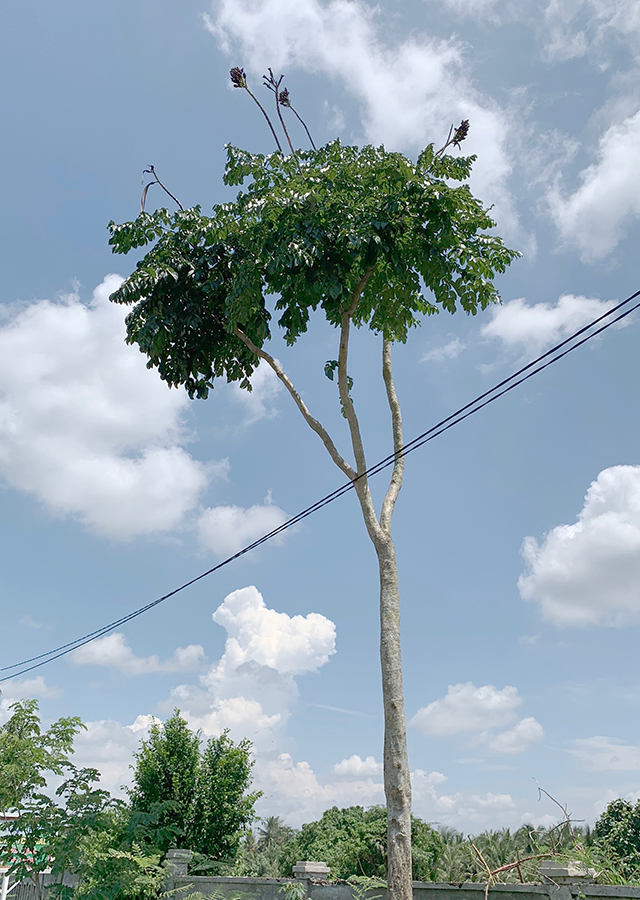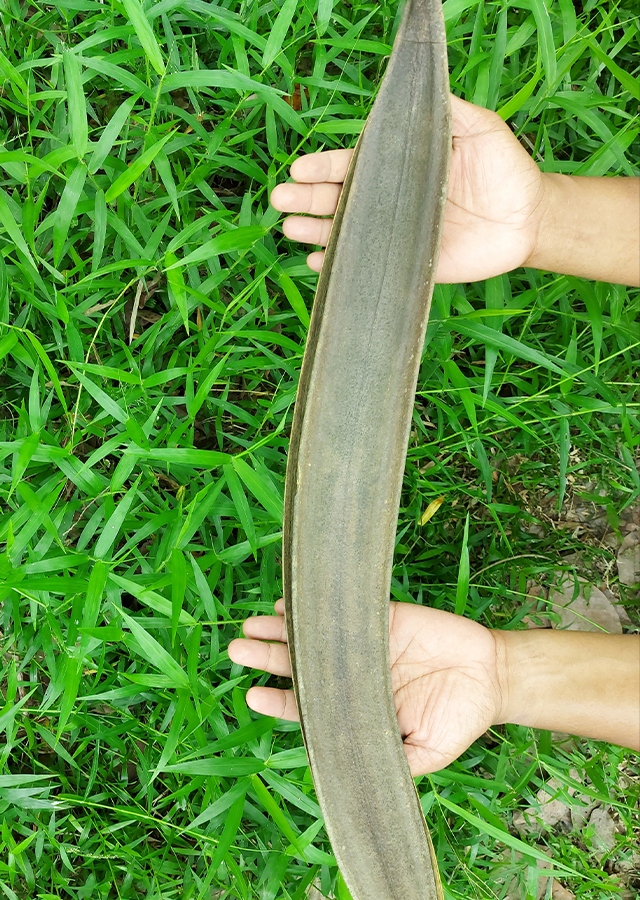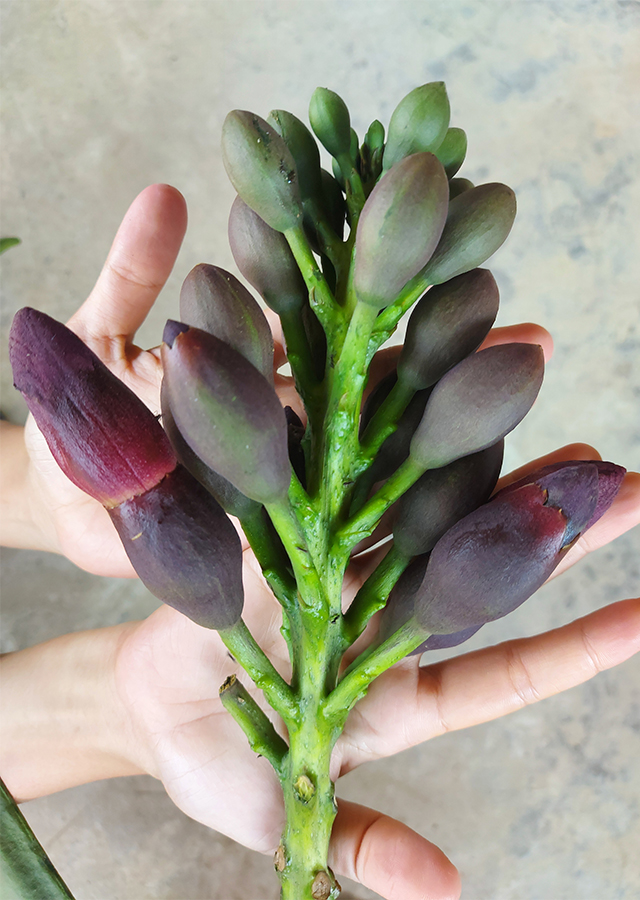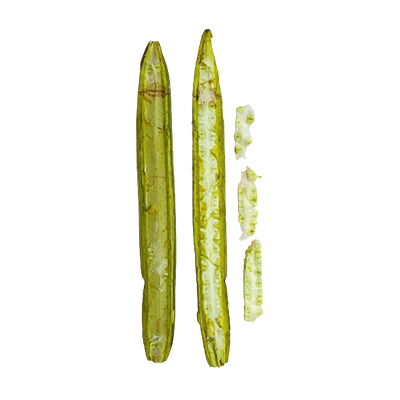Tree of Damocles
Oroxylum indicum (L.) Kurz
Bignoniaceae
Location in our garden
Principal



Synonym
Bignonia indica L.
Bignonia lugubris Salisb.
Bignonia pentandra Lour.
Habitus
Trees. A fast-growing, lanky and sparsely limbed evergreen or partly deciduous perennial tree, can grow 10 to 20 m tall .
Part Used
Leaves
Seeds
Bark
Roots
Growing Requirements
Full Sunshine
Need Shade
Habitat
Forest
Roadside
Overview
Tree of Damocles is native to India, Ceylon, and Southeast Asia. The tree is commonly used as a traditional medicinal plant, its young fruits and flowers are usually served as food due to its crispness, softness, and slight bitterness. This plant can enhance the taste of food and conceal tastes of food, but provide medicinal benefits in the relief and treatment of various diseases.
Vernacular Names
Hanyu pinyin (Chinese), Phari (India), Lin may (Laos), Beka (Malaysia), Tatelo (Nepalese), Pingka-pingkahan (Philippines), Totila (Sri Lanka), Trú’ng cá (Vietnamese).
Agroecology
It is a short-lived nomad tree, easily grow, always encountered in canopy openings, secondary forests and thickets. This plant tolerates a wide range of both climatic and soil conditions, and occurs mostly below 1,000 m altitude.
Morphology
- Bark - soft light brown or grayish-brown with corky lenticels.
- Leaves - very large, 90-180 cm long 2-3 pinnate with 5 or more pairs of primary pinnae, rachis very fast, cylindrical, swollen at the junction of branches, leaflets 2-4 pairs ovate or elliptic, acuminate, glabrous.
- Flowers - bisexual, pedicel 2-4 cm long, bracteolate, calyx coriaceous, campanulate, containing water in bud, brown or dirty violet, funnel-shaped corolla, about 10 cm long, 5 lobes, wrinkled subequal margin, reddish outside, yellowish to pinkish inside; stamens 5, hairy at the base; bloom at night and emit foetid smell.
- Fruit - a pendant capsule, sword-shaped, 45- 120 cm × 6-10 cm, flat valves, almost woody, finally black.
- Seed - 5-9 cm × 2.5-4 cm in size, including the membranous and transparent wing.
Cultivation
- The tree can be propagated by seed or stem cuttings.
- Seed should be collected from closed fruits to prevent fungal attack. Soak the seeds 24 h prior to sowing and planting at 0.5 cm depth.
Chemical Constituents
Alkaloids, flavonoids, tannins, glycosides, sterol, saponins, phenols, quinones, baicalein-7-O-diglucoside (oroxylin B), baicalein-7-O-glucoside, chrysin, apegenin, scutellarein, tetuin, prunetinsitosterol, oroxindin, ellagic acid, biochanin-A, baicalein, 6,7-glucuronides, antraquinone, aloe-emodin.
Traditional Medicinal Uses
- Root bark is acrid, bitter, pungent, astringent to the bowels, treat bile problems, cooling, aphrodisiac, tonic, increases appetite, useful in “vata”, biliousness, cough, fevers, bronchitis, intestinal worms, vomiting, leucoderma, asthma, inflammation, anal troubles, to treat diarrhoea, dysentery, diaphoretic, and rheumatism.
- Extracts of the stem bark and root have been shown to have antimicrobial activities against a range of both gram-positive and gram-negative bacteria and also the yeast Candida albicans. The isolated flavonoid baicalein has shown inhibitory effects against the human T cell leukaemia virus type 1, and the human immunodeficiency virus (HIV-1).
- Fruits are acrid, anthelmintic, effective in diseases of the throat and heart, bronchitis, used as an expectorant, improves the appetite, and useful in leucoderm.
- The leaves are analgesic and has antimicrobial activity.
- Bark and seeds are carminative, stomachic, and diaphoretic. It is used in fever, pneumonia and respiratory troubles.
- Seeds are purgative and taken orally to treat throat infections and hypertension. A seed paste is applied to treat boils and wounds.
- Leaves are prescribed for snake bite, used externally to treat an enlarged spleen and also to alleviate headaches and ulcers.
Part Used
Reference Sources
- Deka,D.C., V. Kumar, C. Prasad, K. Kumar, B.J. Gogoi, L. Singh, R.B. Srivastava. (2013). Oroxylum indicum– a medicinal plant of North East India: An overview of its nutritional, remedial, and prophylactic properties. Journal of Applied Pharmaceutical Science Vol. 3 (Suppl 1), pp. S104-S112. DOI: 10.7324/JAPS.2013.34.S19. https://www.japsonline.com/admin/php/uploads/951_pdf.pdf (Accessed 17-11-2021).
- Fern, Ken. (2014). Useful Tropical Plants. Oroxylum indicum L. Vent. http://tropical.theferns.info/viewtropical.php?id=Oroxylum+indicum (Accessed 14-09-2020).
- Rasadah, M.A. (2016). Pl@nt Use. Oroxylum indicum (PROSEA). https://uses.plantnet-project.org/en/Oroxylum_indicum_(PROSEA) (Accessed 14-09-2020).



